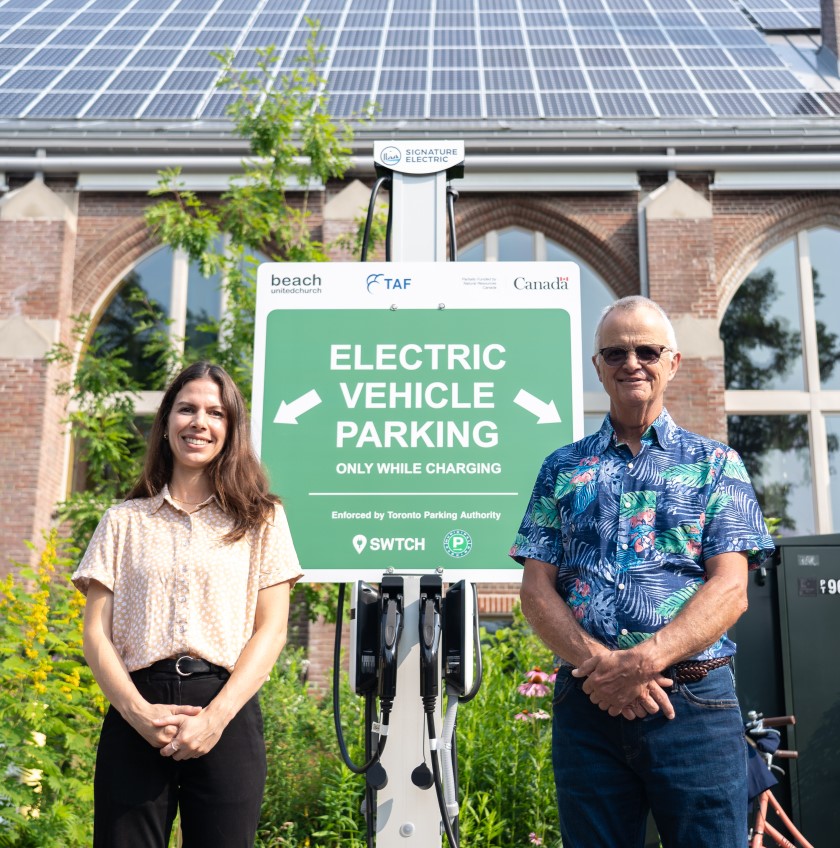October 2023
Ian Klesmer, Director, Strategy and Grants, The Atmospheric Fund
The electric vehicle (EV) future is upon us, with the federal government setting regulated targets to ensure 100% of new vehicle sales be zero emission vehicles by 2035. Meanwhile, attention is focused on how and where we are going to establish the charging infrastructure to facilitate EV ownership and use across all segments of society.
With one-third of Canadians housed in multi-family buildings, we need to ensure that robust EV charging infrastructure is in place to support EV adoption by condo and apartment residents. In fact, both the federal government and Canada’s larger cities will be unable to meet their EV targets if these residents do not have affordable, accessible charging infrastructure at their disposal.
Home charging offers many benefits. It is preferred by most EV owners due to its convenience and affordability, and it reduces the need for government investment in costly public charging infrastructure – especially Level 3 fast charging which is more necessary in the public realm. However, a lower proportion of multi-family building residents have access to home charging than residents of single-family homes. This is due to the considerable costs and other challenges associated with installing charging in condos and apartments. For those residents who are unable or unwilling to depend on public or workplace charging, a lack of home charging represents a significant barrier to vehicle electrification.
Getting started on EV Charging in multi-family buildings
The Atmospheric Fund (TAF) is helping to address this issue through its EV Station Fund, a program that’s supporting the rollout of priority EV charging across the Greater Toronto and Hamilton Area (GTHA). Launched in January 2022 with funding of $2 million from Natural Resources Canada’s Zero Emission Vehicle Infrastructure Program, the EV Station Fund provides applicants with technical and financial support, including up to a 50% contribution towards the cost of installation. TAF’s program has a strong focus on getting charging infrastructure into multi-family buildings and other underserved locations, such as neighbourhoods served by on-street parking.

So far, the program is striking a chord, with TAF’s first $2 million tranche of funding quickly spoken for. Participants noted that they appreciated the technical support and advice offered through the program, and that the funded initiatives sparked excitement and led to subsequent expansion of their charging infrastructure. The first phase of the program saw 234 chargers installed in 16 multi-family buildings along with an additional 128 chargers installed in other sites. Based on this success, TAF received a second tranche of $3 million in funding and altogether, roughly 800 charger installations will be achieved in “hard to reach” sites in the GTHA by the end of 2024.
TAF’s experience working with local building owners has nevertheless shed light on a limitation in the program, which allows funding of up to 20 level 2 chargers in any given building. This would not meet the number of chargers that will ultimately be required in the larger residential towers across the country, as they often have several hundred parking spaces. TAF is considering what supports might be needed to facilitate home charging access for the millions of condo and apartment residents across the country who need to use a car.
The national need for comprehensive EV-ready retrofits
Comprehensive EV-ready retrofits can enable widespread EV adoption among apartment and condo residents much more cost-effectively than an incremental approach to adding EV charging. By comprehensive EV-ready retrofits, we are referring to retrofits that equip 100% of the parking stalls in a building (or as close to that figure as possible) with an adjacent electrical outlet (for example, a junction box or a receptacle) where an EV charger can be installed in the future. While the cost of undertaking a comprehensive EV-ready retrofit in an existing multi-family building involves a larger upfront investment, this investment is much more economical in the long run than undertaking multiple projects to install a small number of charging stations at a time. However, there are multiple barriers to the scaling of comprehensive EV-ready retrofits in Canada, including upfront capital costs and the challenges of identifying and co-ordinating the appropriate equipment and approach. TAF is working to provide help on both fronts.
To promote the affordability of EV-readiness at a national scale, TAF and its partners have recommended the federal government to expand EV charging access for multi-family residents through for local and national entities to support comprehensive EV-ready planning and retrofits in these buildings. TAF is also collaborating with the LC3 Network and the Green Municipal Fund to identify the optimal approach to installing comprehensive EV-ready infrastructure in multi-family buildings so that the EV wave does not leave condo and apartment residents behind. If you are interested in either initiative, please feel free to contact me at iklesmer@taf.ca.
Generating significant carbon and public health benefits
In the GTHA, transportation accounts for 31.4% of greenhouse gas emissions, so electrifying how people and goods move around our cities is a critical strategy for achieving carbon reduction targets. The strategy brings other benefits as well, from reduced lifetime car ownership costs to dramatic reductions of air pollution that is negatively affecting urban populations – especially those that live adjacent to busy roadways. In fact, a recent analysis by TAF using Health Canada metrics projects that EV transition will generate $90 billion in health benefits for Canadians over the next 25 years, including up to 11,000 avoided premature deaths.
Many cities are already transforming transportation by prioritizing active, shared, and public transportation over personal vehicles. EV adoption is part of a broader sustainable transportation framework that improves mobility and reduces emissions by facilitating active and shared transportation, improving urban design, and reducing overall travel demand. Yet, without transitioning the remaining vehicles on city roads to EVs, Canada and Canadian cities will not meet their climate targets.
The bottom line is, getting adequate charging infrastructure installed quickly – and equitably – in Canadian cities is an important task. Getting experience on the ground with building owners is helping show the way, but more comprehensive approaches are needed.
